| This article needs additional citations for verification. Please help improve this article by adding citations to reliable sources. Unsourced material may be challenged and removed. Find sources: "Toyota Sprinter Trueno" – news · newspapers · books · scholar · JSTOR (January 2021) (Learn how and when to remove this message) |
Motor vehicle
| Toyota Sprinter Trueno | |
|---|---|
 Toyota Sprinter Trueno (AE86) Toyota Sprinter Trueno (AE86) | |
| Overview | |
| Manufacturer | Toyota |
| Also called | Toyota Corolla Levin |
| Production | March 1972 – August 2000 |
| Body and chassis | |
| Class | |
| Body style | |
| Layout |
|
| Chronology | |
| Predecessor | Toyota Corolla Sprinter |
| Successor | Toyota Celica (T230) (integrated) |
The Toyota Sprinter Trueno (トヨタ・スプリンタートレノ, Toyota Supurintā Toreno) is a series of compact sports coupés and liftbacks which were produced by Toyota from 1972 to 2000. The name trueno in Spanish means thunder. In Japan, the Sprinter Trueno was exclusive to Toyota Auto Store locations.
Its twin, the Toyota Corolla Levin (トヨタ・カローラレビン, Toyota Karōra Rebin), was produced in parallel with the Sprinter Trueno. In Middle English, levin means lightning. In Japan, the Corolla Levin was exclusive to Toyota Corolla Store locations.
TE27 Series (1972–1974)
Motor vehicle| First generation | |
|---|---|
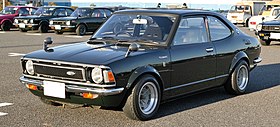 Toyota Corolla Levin (TE27, pre-facelift) Toyota Corolla Levin (TE27, pre-facelift) | |
| Overview | |
| Model code | TE27 |
| Production | 1972–1974 |
| Assembly | Takaoka plant, Toyota City, Japan |
| Body and chassis | |
| Body style | 2-door coupé |
| Layout | Front engine, rear-wheel drive |
| Related | |
| Powertrain | |
| Engine |
|
| Transmission | 5-speed T50 manual |
| Dimensions | |
| Wheelbase | 2,335 mm (91.9 in) |
| Length |
|
| Width | 1,505 mm (59.3 in) |
| Height | 1,335 mm (52.6 in) |
| Curb weight | 855–865 kg (1,885.0–1,907.0 lb) |
The first generation of the Sprinter Trueno and Corolla Levin was the high performance models of Corolla and Sprinter 2-door fastback coupé, introduced in March 1972. The inspiration for these compact sport coupés came from Toyota manager Geisuke Kubo who wanted to offer something similar to the Alfa Romeo Giula Junior. The highest performance version of the twin coupés was powered by the high compression (9.8:1) DOHC 2T-G engine with twin double venturi side draft 40 mm Mikuni-Solex 40PHH carburettors and mated to a T50 5-speed manual transmission, borrowed from the bigger TA27 Celica 1600GT. This engine produced 115 PS (85 kW; 113 hp) gross, with claimed top speed of 190 km/h (118 mph) and able to complete a 1⁄4 mile (400 m) sprint in 16.3 seconds. A lower compression (8.8:1) 2T-GR engine option was also available for customers who preferred using cheaper, lower octane fuel. This engine was 5 PS (4 kW; 5 hp) less powerful, which also lowered the top speed to 185 km/h (115 mph) and quarter mile time to 16.7 seconds.
An updated model appeared shortly in August in the same year with the refreshed appearance. Another update was introduced in April 1973 with the introduction of less powerful model called J (Junior), powered by an OHV twin carburettor version of the 2T-G engine called the 2T-B/BR, shared with the lower priced Corolla/Sprinter 1600 SR coupé. These engines produced 100–105 PS (74–77 kW; 99–104 hp) in gross power, with claimed a top speed of 170–175 km/h (106–109 mph) and a quarter mile time of over 17 seconds. Vehicles installed with the 1.6 litre engine obligated Japanese owners to pay more annual road tax, as the displacement exceeds the 1000–1500 cc tax bracket.
-
Corolla Levin (TE27, pre-facelift)
-
 Corolla Levin (TE27, facelift)
Corolla Levin (TE27, facelift)
-
 Corolla Levin (TE27, facelift)
Corolla Levin (TE27, facelift)
-
 Sprinter Trueno (TE27, facelift)
Sprinter Trueno (TE27, facelift)
-
 Sprinter Trueno (TE27, facelift)
Sprinter Trueno (TE27, facelift)
-
 The 2T-G DOHC 8-valve engine, developed by Yamaha based on the 2T OHV engine
The 2T-G DOHC 8-valve engine, developed by Yamaha based on the 2T OHV engine
TE37, TE47, TE51, TE55, TE61 & TE65 Series (1974–1975, 1977–1979)
Motor vehicle| Second generation | |
|---|---|
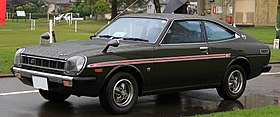 Toyota Sprinter Trueno GT (TE47, pre-facelift) Toyota Sprinter Trueno GT (TE47, pre-facelift) | |
| Overview | |
| Model code | TE47/61/65 (Sprinter Trueno) TE37/51/55 (Corolla Levin) |
| Production | 1974–1975 1977–1979 |
| Assembly | Takaoka plant (Kanto Auto Works), Toyota City, Japan |
| Body and chassis | |
| Body style | 2-door coupé 2-door hardtop coupé (TE37 Corolla Levin only) |
| Layout | Front engine, rear-wheel drive |
| Related | |
| Powertrain | |
| Engine |
|
| Transmission | |
| Dimensions | |
| Wheelbase | 2,370 mm (93.3 in) |
| Length |
|
| Width |
|
| Height |
|
| Curb weight | 925–965 kg (2,039.3–2,127.5 lb) |
 Sprinter Trueno GT (TE47, pre-facelift)
Sprinter Trueno GT (TE47, pre-facelift)
 Very rare TE37 Corolla Levin with hardtop coupé body
Very rare TE37 Corolla Levin with hardtop coupé body
With the introduction of the second generation Sprinter Trueno and Corolla Levin in April 1974, there was a clearer difference between the two through design. Though based on the same platform, the whole design differed totally with the Sprinter Trueno (TE47) was offered as a coupé and had a sleeker and more curved design. In contrast to the Corolla Levin (TE37), it was only available as a hardtop coupé with an aggressive forward raked nose design similar to the sedan version. Both models were still powered by the same 2T-G/GR engines and mated to the same T50 5-speed manual transmission. The twins was also available with a better equipped GT sub-trim. Due the incompatibility with the Japanese emission regulations, the coupés were discontinued in November 1975.
Toyota reintroduced the twin coupés in January 1977 with a minor facelift and also the new fuel injected version of the 2T-G engine with the Toyota Total Clean-Catalyst (TTC-C) emission control technology, with the installation of catalytic converter to pass the Japanese 1976 emission regulation, now called the 2T-GEU. The Corolla Levin (TE51) was also changed to a regular coupé body style just like the Sprinter Trueno (TE61), but still with a drastic difference on the nose. In September 1977, Toyota launched a limited edition called Black Trueno, based on the GT trim and limited to 550 units (together with 1000 units of the T120 series Corona Black Limited Edition sedan/coupé, to celebrate its 20th anniversary). Two months later in November, the Levin GT received the same limited edition and available for 1000 units. This limited edition was only offered in black coloured body, special brown mats and body decals, "Limited Edition 550 or 1000" mark on the body, a plate with the owner's name engraved on it placed above the glove box and a black mug for the Levin. The similar limited edition was later released for the AE86 Sprinter Trueno Black Limited liftback in 1986. Another facelift was introduced in April 1978 with the implementation of longer shock-absorbing front bumper and the advanced TTC-C with three-way catalytic converter because of the stricken emission regulation. The Corolla Levin and Sprinter Trueno now bearing TE55 and TE65 codes, respectively.
The TE47 Sprinter Trueno was exported to Belgium and Luxembourg, while the rest of the world received the regular Corolla hardtop coupé version. It was marketed with three trim levels; LT with the plain 2T engine and 4-speed T40 manual transmission, ST with the twin carburettors 2T-B engine and 5-speed T50 manual transmission and the GT which used the same powertrain as the Japanese-spec Sprinter Trueno.
-
 Sprinter Trueno GT (TE61, first facelift)
Sprinter Trueno GT (TE61, first facelift)
-
Corolla Levin (TE51, first facelift)
-
 Sprinter Trueno GT (TE65, second facelift)
Sprinter Trueno GT (TE65, second facelift)
-
 Rear view of facelifted TE61/65 Sprinter Trueno GT
Rear view of facelifted TE61/65 Sprinter Trueno GT
-
 Toyota Corolla Levin GT (TE55, second facelift)
Toyota Corolla Levin GT (TE55, second facelift)
-
 Rear view of facelifted TE51/55 Corolla Levin GT
Rear view of facelifted TE51/55 Corolla Levin GT
TE71 Series (1979–1983)
Motor vehicle| Third generation | |
|---|---|
 Toyota Corolla Levin (TE71, pre-facelift) Toyota Corolla Levin (TE71, pre-facelift) | |
| Overview | |
| Model code | TE71 |
| Production | 1979–1983 |
| Assembly | Takaoka plant, Toyota City, Japan |
| Body and chassis | |
| Body style | 3-door liftback |
| Layout | Front engine, rear-wheel drive |
| Related | |
| Powertrain | |
| Engine | 1.6 L 2T-G/GEU DOHC I4 |
| Transmission | 5-speed T50 manual |
| Dimensions | |
| Wheelbase | 2,400 mm (94.5 in) |
| Length |
|
| Width | 1,625 mm (64.0 in) |
| Height | 1,325–1,335 mm (52.2–52.6 in) |
| Curb weight | 955–990 kg (2,105.4–2,182.6 lb) |
The third generation of the Sprinter Trueno and Corolla Levin was released in May 1979, powered by the same 115 PS (85 kW; 113 hp) fuel injected 2T-GEU engine from the previous generation. Unlike previous generations, this generation Trueno and Levin were 3-door liftbacks. This generation was now equipped with 4-wheel disc brakes as standard, rear suspension with coil springs like the E70 Corolla/Sprinter sedan and had a sunroof as an option. In the May 1981 facelift, two new trim levels were added to the line up; the cheaper "S" (with shorter front bumper) and the better optioned "APEX" (with standard Michelin sport tyres).
The Corolla Levin was exported as the Corolla GT for selected markets in Europe, powered by the twin double venturi side draft Mikuni-Solex 40PHH carburettors 2T-G engine, producing 108–110 PS (79–81 kW; 107–108 hp).
-
 Corolla Levin (TE71, facelift)
Corolla Levin (TE71, facelift)
-
 European market Corolla GT (TE71, pre-facelift)
European market Corolla GT (TE71, pre-facelift)
-
 Rear view (pre-facelift)
Rear view (pre-facelift)
-
 European market Corolla GT (TE71, facelift)
European market Corolla GT (TE71, facelift)
-
 2T-GEU engine
2T-GEU engine
AE85 & AE86 Series (1983–1987)
Main articles: Toyota AE85 and Toyota AE86 Motor vehicle| Fourth generation | |
|---|---|
 Toyota Sprinter Trueno GT APEX 3-door liftback (AE86, pre-facelift) Toyota Sprinter Trueno GT APEX 3-door liftback (AE86, pre-facelift) | |
| Overview | |
| Model code | AE85 (1.5 L) AE86 (1.6 L) |
| Production | 1983–1987 |
| Assembly | Takaoka plant (Kanto Auto Works), Toyota City, Japan |
| Body and chassis | |
| Body style | 2-door coupé 3-door liftback |
| Layout | Front engine, rear-wheel drive |
| Related | |
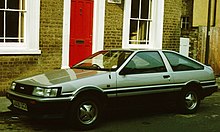 European market Corolla GT 3-door liftback, adopting Corolla Levin styling
European market Corolla GT 3-door liftback, adopting Corolla Levin styling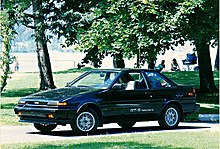 North American market Corolla GT-S coupé, adopting Sprinter Trueno styling
North American market Corolla GT-S coupé, adopting Sprinter Trueno styling
The fourth generation of the Sprinter Trueno and Corolla Levin was released in May 1983 and was offered in 2-door coupé and 3-door liftback body styles. It was the last in the series to use the front-engine, rear-wheel drive platform, carried over from the previous generation with major modifications. From this generation, all of the coupés (and liftbacks in this generation) were marketed with "Trueno/Levin" suffix plus its own trim levels, to separate it from the regular Corolla/Sprinter line up. Also in this generation, the Corolla Levin came with fixed rectangular headlights, while the Sprinter Trueno distinguished itself from the Corolla Levin with its retractable pop-up headlights.
The American Corolla SR-5 and GT-S had the same front-end as the Japanese Trueno, complete with retractable headlights, although it had different and longer bumpers in the front and rear so as to meet US federal standards. European Corolla GTs had the same front-end as the Corolla Levin. The Australian market AE86 also had the Corolla Levin front-end, but with Sprinter taillights and marketed simply as the Sprinter.
 The early 4A-GE engine, also known as "Bigport" or "Blue Top"
The early 4A-GE engine, also known as "Bigport" or "Blue Top" 4A-C engine, powered the lower specification of AE86 in North America, Australia and several other markets
4A-C engine, powered the lower specification of AE86 in North America, Australia and several other markets
From this generation, the outdated 1.6 L DOHC 8-valve 2T-GEU engine was replaced by the modern DOHC 16-valve 4A-GEU engine (called 4A-GEC in North America or simply as 4A-GE for the rest of the world). The new engine is 15 PS (11 kW; 15 hp) more powerful, 23 kg (51 lb) lighter and also 4dB quieter than the old engine. A carbureted SOHC 8-valve version of the new 1.6 L DOHC engine called the4A-C was also available for the cheaper models in North America, Australia and several other markets. Meanwhile, the Japanese market received the 1.5 L SOHC 8-valve version called the 3A-U, exclusively for the AE85 range. These SOHC engines were inherited from the previous E70 series Corolla/Sprinter range. Automatic transmission option was also available for this generation, first time in Sprinter Trueno/Corolla Levin range.
AE91 & AE92 Series (1987–1991)
Motor vehicle| Fifth generation | |
|---|---|
 Toyota Sprinter Trueno GT-Z (AE92, pre-facelift) Toyota Sprinter Trueno GT-Z (AE92, pre-facelift) | |
| Overview | |
| Model code | AE91 (1.5 L) AE92 (1.6 L) |
| Also called | Toyota Corolla Sport Coupe (North America) |
| Production | 1987–1991 |
| Assembly |
|
| Body and chassis | |
| Body style | 2-door coupé |
| Layout | Front engine, front-wheel drive |
| Related | |
| Powertrain | |
| Engine |
|
| Transmission |
|
| Dimensions | |
| Wheelbase | 2,430 mm (95.7 in) |
| Length |
|
| Width |
|
| Height |
|
| Curb weight |
|
The fifth generation of the Sprinter Trueno and Corolla Levin was introduced in May 1987. This generation had several changes from the previous generation, the most notable being the omission of the front-engine, rear-wheel drive (FR) layout of the previous generation in favour of a more conventional front-engine, front-wheel drive (FF) layout in-line with the other Corollas of the same generation. The 3-door liftback body style was no longer offered in this generation, leaving only the 2-door coupé as the sole variant.
As with the preceding AE85/86 models of the previous generation, it had two different front end styles for each models. The Sprinter Trueno had a much more slanted front fascia with retractable pop-up headlights, while the Corolla Levin had a much more levelled bonnet line with fixed rectangular headlights. New to the sporty coupés was the supercharged GT-Z trim, which was the highest and fastest trim level of the AE92 at the time. This trim comes equipped with a supercharged version of the 4A-GE engine called the 4A-GZE, combined with an SC12 roots type supercharger and a top mounted intercooler. This new engine had been previously used in the supercharged AW11 MR2 a year prior to the introduction of the E90 series Sprinter/Corolla.
For the AE91 series, the new G, L, Xi and Zi trim levels replaced the previous generation's GL, XL, SR and SE trim levels of the AE85 respectively, with G (Levin) and L (Trueno) featuring the carburettor 1.5 L 5A-F engine. The better equipped Xi (Trueno) and Zi (Levin) featured the more economical fuel injected 1.5 L 5A-FE. The female-oriented XL-Lissé and GL-Lime models of the AE85 were carried over to the AE91 series and were renamed as just Lime (Levin) and Lissé (Trueno), while retaining their same purpose. The Lime and Lissé were the luxury variants of the G and L trims, featuring unique upholstery, power steering, and an automatic transmission, among others.
All cars came with either a 5-speed manual, a 4-speed automatic (Xi, Zi, GT, GTV and GT-APEX) or a 3-speed automatic (G, L, Lime and Lissé). On the GT-APEX model, a semi-active suspension technology called Toyota Electronic Modulated Suspension (TEMS) and a digital cluster similar to the one found in the AE86 GT-APEX models were also offered as factory options.
The early models, known as the "Zenki" (前期) generation, were introduced in 1987. The engines in the earlier models were less powerful compared to the later models, with the naturally-aspirated 4A-GE producing 120 PS (88 kW; 118 hp), the same power figures as the first generation 4A-GE in net output. The supercharged 4A-GZE on the other hand produces 145 PS (107 kW; 143 hp), the same power figures as the engine found in the supercharged AW11 MR2. The 4A-GE engines in this generation were late "bigport" versions, denoted by the red-and-black lettering on the cam covers. These engines (aside from the 4A-GZE) retained the T-VIS intake system from the early "bigport" versions found in the previous AE86 models, among other minor changes. The carbureted 5A-F producing 85 PS (63 kW; 84 hp), while the fuel injected 5A-FE is 9 PS (7 kW; 9 hp) more than the 5A-F. Other distinct features on the Zenki models included different front bumpers for the Levin's front end, having a different design with a small upper grille that extends to both ends of the bumper. The Trueno's front bumper design was similar to the preceding facelifted AE86, while also having combo lights between the headlights and bumpers. In early 1989, a limited edition based on Levin GT APEX called Black Levin 204 was added to the line up, with a limited run of 520 units. The car was painted with export specification 204 code black metallic paint, yellow halogen bulb headlights and standard electric moonroof for 240 units only.
In May 1989, the model received a minor facelift as well as changes in engine performance, also known as the "Kouki" (後期) generation. Major reworking was done to the 4A-GE engine, replacing the twin-runner T-VIS intake system with a single-runner intake featuring smaller intake ports, hence the nickname "smallport". These engines are denoted by the all-red lettering found in the cam covers. Along with a couple of upgrades (mainly to the engine internals), this version produces 20 PS (15 kW) more than the previous iteration, with 140 PS (103 kW) in naturally aspirated form, and 165 PS (121 kW; 163 hp) in supercharged 4A-GZE form as a result of this change. The minor tweaks also upped the compression ratio from 9.4:1 to 10.3:1 (NA models) and from 8:1 to 8.9:1 (supercharged models). The trim grades were also revised, the AE92 GT-V was deleted and AE91 L was renamed to G. Furthermore, the AE91 Xi and Zi trims became the XS and ZS. The carburettor 5A-F engine was no longer offered during this generation, therefore eliminating all carbureted engines from the lineup. The G, Lime and Lissé trims of the AE91 now had the revised fuel injected 5A-FE, while the XS and ZS have the 5A-FHE EFI-S engine producing 105 PS (77 kW; 104 hp). The front bumper of the Levin now had a shorter upper grille that did not extend to both ends, with two side markers on each corner. The Trueno also carried this change as well, differing with larger combo lights above the bumper and below the headlights. The 1989 limited edition was revived with different options for the Trueno GT Apex in January 1990, called the GT APEX Limited and limited to 2000 units. The same limited edition was later rereleased in January 1991 for both coupés and limited to 1000 units. The black body paint was changed to 205 code and available for GT APEX trim.
For the North American market, the GT-S and SR-5 AE92 coupés came in the same configuration as with the prior AE86 models, being based on the Trueno with retractable headlights and Levin taillights. Like the previous generation, it had longer bumpers in the front and rear so as to satisfy US federal regulations. The supercharged 4A-GZE engine was never offered in the US-market AE92 coupés (although it was available for the AW11 MR2), however, as the GT-S only came with a naturally aspirated version of the "bigport" 4A-GE engine, producing 117 PS (86 kW; 115 hp), 3 PS (2 kW; 3 hp) less than the Japanese-market "bigport" 4A-GE engine. Other differences include the use of a MAF sensor on US-market engines as opposed to a MAP sensor on Japanese-market engines. The SR-5 came with a carbureted 4A-F engine producing 95 PS (70 kW; 94 hp). The GT-S was only available with a 5-speed manual transmission, while the SR-5 was available with a 3-speed automatic transmission option. In the 1990 model year update, the GT-S was updated with new "smallport" 4A-GE engine, producing 132 PS (97 kW; 130 hp). The lower SR-5 was also upgraded with 4A-FE fuel injected engine, producing 103 PS (76 kW; 102 hp)
This generation was also exported with "general specification" as the Corolla Coupe to selected markets, such as Chile, Hong Kong or Malta. Just like the North American model Corolla Sport Coupe, it also had Trueno retractable headlights and Levin taillights hybrid, but using the Japanese market bumpers. The coupé was only offered with a sole trim called XL. Only the carbureted 1.6 L 4A-F was available in these markets, mated to either 5-speed manual or 3-speed automatic option.
-
 Sprinter Trueno GT APEX (AE92, pre-facelift)
Sprinter Trueno GT APEX (AE92, pre-facelift)
-
 Corolla Levin Zi (AE91, pre-facelift)
Corolla Levin Zi (AE91, pre-facelift)
-
 Corolla Levin Zi (AE91, pre-facelift)
Corolla Levin Zi (AE91, pre-facelift)
-
 Sprinter Trueno (AE91, facelift)
Sprinter Trueno (AE91, facelift)
-
 Corolla Levin ZS (AE91, facelift)
Corolla Levin ZS (AE91, facelift)
-
 Corolla Levin ZS (AE91, facelift)
Corolla Levin ZS (AE91, facelift)
-
 North American market Corolla Sport Coupe SR-5 (AE92)
North American market Corolla Sport Coupe SR-5 (AE92)
-
 North American market Corolla Sport Coupe GT-S (AE92)
North American market Corolla Sport Coupe GT-S (AE92)
-
 4A-GZE engine
4A-GZE engine
-
 The 1989 update "Smallport" or "Red Top" 4A-GE engine
The 1989 update "Smallport" or "Red Top" 4A-GE engine
-
 The carbureted 4A-F engine
The carbureted 4A-F engine
-
 The early version of fuel injected 4A-FE engine for the 1990–1992 model years North American SR-5 coupé
The early version of fuel injected 4A-FE engine for the 1990–1992 model years North American SR-5 coupé
AE100 & AE101 Series (1991–1995)
Motor vehicle| Sixth generation | |
|---|---|
 Toyota Sprinter Trueno GT APEX (AE101, facelift) Toyota Sprinter Trueno GT APEX (AE101, facelift) | |
| Overview | |
| Model code | AE100 (1.5 L) AE101 (1.6 L) |
| Production | 1991–1995 |
| Assembly |
|
| Body and chassis | |
| Body style | 2-door coupé |
| Layout | Front engine, front-wheel drive |
| Related | |
| Powertrain | |
| Engine | |
| Transmission |
|
| Dimensions | |
| Wheelbase | 2,465 mm (97.0 in) |
| Length |
|
| Width | 1,695 mm (66.7 in) |
| Height | 1,305 mm (51.4 in) |
| Curb weight | 980–1,150 kg (2,160.5–2,535.3 lb) |
The Sprinter Trueno and Corolla Levin underwent a full model change in June 1991 with the sixth generation models, based on the E100 series. Japanese Formula 1 driver Ukyo Katayama was appointed as the image representative for marketing as he was popular in Japan at the time. A commercial was broadcast in which Katayama runs a Levin on the Mine circuit with the catchphrase "右京、レビンす" (Ukyo, Levin).
Developed during the peak of the Japanese asset price bubble in the early 90's, the latest technologies in body, chassis, engine, transmission and safety were put into the new E100 series. Consequently, the body size increased nearly to the maximum width the Japanese government regulations would allow for compact cars (1,700 mm (66.9 in)) and became 70–80 kg (154.3–176.4 lb) heavier, which made it less attractive as a sports compact model than previous generations.
The series continued to follow the same tradition of offering two separate styles and names, sold to different brand dealers in Japan. Unlike with previous generations, however, the E100 twin coupés were not officially exported elsewhere, making these models exclusive to Japan.
The chassis was all new in this generation, with a much higher and rigid body than the previous generation E90 series. This new chassis would later be carried over to the next-generation E110 series as part of a cost-cutting measure made during the Lost Decades recession that happened throughout the 1990s. Sharing the same wheelbase as with the Corolla/Sprinter sedans, the suspension featured re-tuned front and rear MacPherson struts.
The biggest improvement in this generation, however, was the high-performance 4A-GE engine found in the GT, GT APEX and GT APEX Limited (January 1992 only). Many of the parts were redesigned, with the intake side camshaft now having Toyota's Variable Valve Timing or VVT (a precursor to the later VVT-i with a discontinuous variable valve timing mechanism), and used a five-valve-per-cylinder head design (three inlet, two exhaust) for a total of 20 valves. This was seen as revolutionary at that time as Yamaha, who typically collaborated with Toyota to produce their high-performance engines, were actively using five-valve-per-cylinder designs in their 1985–2007 Genesis engined sport bikes. Mitsubishi was the first automobile manufacturer to offer five-valve-per-cylinder engine in 1989 with their 3G81 engine. The valve covers have been redesigned in tandem with a new cylinder head, featuring silver cam covers with chrome lettering, hence the name "Silver Top". In addition, it was equipped with individual throttle bodies to increase engine throttle response, which was rare for a commercial vehicle of its class. A MAF sensor was used instead of a MAP sensor, however, unlike with the 16-valve "smallport" version of the 4A-GE engine offered in the earlier AE92 series. Because of this, it requires the use of an intake plenum. Maximum power was 160 PS (118 kW; 158 hp). The supercharged 4A-GZE engine offered in the GT-Z still kept the same 16-valve head as with the previous versions, but it did have as many changes to the engine internals as well as a minor cosmetic change in the top-mounted intercooler that featured Toyota's then-new logo. It produced 170 PS (125 kW; 168 hp).
New body panels were introduced in this generation for both the Trueno and the Levin, with the front bumper design of the Trueno being largely similar to the facelifted AE92's front bumper design. However, the most significant design change in this generation was the removal of the retractable pop-up headlights used in the Trueno. Due to changing industry trends at the time, the use of hidden headlamps for the Trueno started to wane in popularity in the early 90's after last using them in the E90 series. To compensate for this change, the Trueno switched to fixed headlights similar to the Levin but in the style of the combo lights from the previous generation AE91/92 models so as to make way for a more modern, rounder, aerodynamic and luxury styling whilst maintaining the distinction between the Levin and the Trueno with the latter's front fascia design. The series was given a minor facelift in May 1993, which included revised bumpers and taillights. On the Trueno, this included a slightly larger grille on the front bumper.
The trim grades were also revised at the start of this generation, simplifying the lineup from six different trim grades down to five. The low-priced S trim grade, as part of the AE100 series, replaced the previous G trim grade of the AE91 series and received the economical 1.5 L 5A-FE engine, which produced 105 PS (77 kW; 104 hp). This trim received a limited edition version called S Limited in December 1994. The successor to the preceding ZS and XS trim grades was the SJ, which featured the updated 4A-FE engine producing 115 PS (85 kW; 113 hp). Additional limited edition SJ Limited trim was introduced twice in January 1992 and February 1994. The female-oriented Lime/Lissé trim grade of the AE91 series was dropped.
An updated TEMS electronically controlled suspension (upper and lower G-sensitive type called Super Strut Suspension (SSsus), was standard for GT-Z and optional for GT APEX. The GT-Z was also equipped with a viscous limited-slip differential (LSD) as standard equipment.
-
 Sprinter Trueno GT APEX (AE101, pre-facelift)
Sprinter Trueno GT APEX (AE101, pre-facelift)
-
 Sprinter Trueno GT APEX (AE101, facelift)
Sprinter Trueno GT APEX (AE101, facelift)
-
 Corolla Levin GT APEX (AE101, pre-facelift)
Corolla Levin GT APEX (AE101, pre-facelift)
-
 Corolla Levin GT APEX (AE101, facelift)
Corolla Levin GT APEX (AE101, facelift)
-
 Corolla Levin GT APEX (AE101, facelift)
Corolla Levin GT APEX (AE101, facelift)
-
"Silver Top" 20-valve 4A-GE engine
-
 The updated 4A-FE engine
The updated 4A-FE engine
AE110 & AE111 series (1995–2000)
Motor vehicle| Seventh generation | |
|---|---|
 Toyota Sprinter Trueno BZ-G (AE111, pre-facelift) Toyota Sprinter Trueno BZ-G (AE111, pre-facelift) | |
| Overview | |
| Model code | AE110 (1.5 L) AE111 (1.6 L) |
| Production | 1995–2000 |
| Assembly |
|
| Body and chassis | |
| Body style | 2-door coupé |
| Layout | Front engine, front-wheel drive |
| Related | |
| Powertrain | |
| Engine | |
| Transmission |
|
| Dimensions | |
| Wheelbase | 2,465 mm (97.0 in) |
| Length |
|
| Width | 1,695 mm (66.7 in) |
| Height | 1,305 mm (51.4 in) |
| Curb weight | 950–1,110 kg (2,094.4–2,447.1 lb) |
The seventh and final generation of the Sprinter Trueno and Corolla Levin was introduced in May 1995. This is the last series to use the Sprinter Trueno name, and the last to be offered as a sport compact coupé. It shared many of the same parts and platform as its predecessor due to the Lost Decades recession that was happening in Japan at the time. The first models (known as Zenki) were manufactured from 1995 to 1997, with the facelifted models (known as Kouki) manufactured from 1997 to 2000. The series continued to use different styles for the Levin and Trueno, however by 1997 the front fascia would be changed to a more subtle design that is nearly identical to each other with some slight differences.
The weight of the twin coupés was reduced significantly with the revised structural design, the use of Toyota Super Olefin Polymer (TSOP) thermoplastic resin materials for the bumpers and interior and several other modifications.
New trim levels were introduced, replacing the S, SJ, GT and GT-APEX trims of the previous generation. These are FZ, XZ, BZ-V, BZ-G and BZ-R. Initially, the lineup consisted of the FZ, XZ, BZ-V and BZ-G trims. The low-priced FZ (also limited edition FZ Limited released in December 1995 and 1996) featured the detuned 1.5 L 5A-FE engine with revised intake, now producing 100 PS (74 kW; 99 hp), while the XZ featured the 1.6 L 4A-FE engine, and the BZ-V, BZ-G and BZ-R all featured the 20-valve 4A-GE engine. The 4A-GE in this generation was updated with revised internals, the replacement of a MAF sensor with a MAP sensor, and a new valve cover, this time in black, hence the name "Black Top". This new 4A-GE engine produced 165 PS (121 kW; 163 hp). The supercharged GT-Z trim with the 4A-GZE engine is dropped.
A minor change was released in May 1996, the driver's side airbag and ABS became standard safety equipment for all trim levels. The lineup would be refreshed one final time in April 1997, dropping the BZ-V trim while adding the new BZ-R and BZ-R V trims. The BZ-R trim featured a 6-speed manual transmission, LSD, bigger front rotors, improved calipers, a taller rear spoiler and Super Strut Suspension (SSsus), all of which could be added to the BZ-G and BZ-R V models as factory options. Additionally, a set of Recaro SR3 (confetti pattern) seats could be installed as a factory option. The safety equipment was once again updated with the implementation of Toyota's Global Outstanding Assessment (GOA) passive safety vehicle body technology, dual airbags and seat belts with pretensioners and force limiters as standard.
With the discontinuation of the Sprinter line in August 2000 (up to 2002 for the wagons, while the Sprinter sedan was replaced by a hatchback called the Allex), the Trueno name was also retired. As for the Corolla Levin, it too was retired in August 2000, with the introduction of the E120 series Corolla that same year. The declining demand of coupés and the effects of the Lost Decades recession, pushing the discontinuation of the twin coupés. Toyota decided to cut their front-wheel drive coupés line up by introducing the T230 series Celica (shared the same platform as the E120 series Corolla) in 1999, which was developed to replace the T200 series Celica, Japan only Curren, Sprinter Trueno and Corolla Levin.
-
Sprinter Trueno BZ-G (AE111, pre-facelift)
-
 Sprinter Trueno XZ (AE111, facelift)
Sprinter Trueno XZ (AE111, facelift)
-
 Sprinter Trueno BZ-G (AE111, facelift)
Sprinter Trueno BZ-G (AE111, facelift)
-
 Corolla Levin FZ (AE110, pre-facelift)
Corolla Levin FZ (AE110, pre-facelift)
-
 Corolla Levin XZ (AE111, pre-facelift)
Corolla Levin XZ (AE111, pre-facelift)
-
 Corolla Levin BZ-G (AE111, facelift)
Corolla Levin BZ-G (AE111, facelift)
-
 Corolla Levin BZ-R (AE111, facelift)
Corolla Levin BZ-R (AE111, facelift)
-
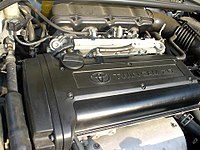 "Black Top" 20-valve 4A-GE engine
"Black Top" 20-valve 4A-GE engine
-
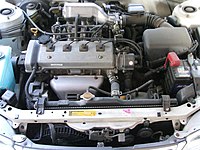 5A-FE engine with updated intake manifold
5A-FE engine with updated intake manifold
Other uses of "Trueno" and "Levin" names
The name "Levin" was later reused for the E110–120 Corolla and E150–180 Auris hatchbacks in Australia and New Zealand, where certain trim levels had the Levin label.
-
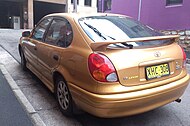 Corolla Levin (E110, Australia)
Corolla Levin (E110, Australia)
-
 Corolla Levin (E120, Australia)
Corolla Levin (E120, Australia)
-
 Corolla Levin ZR (E150, Australia)
Corolla Levin ZR (E150, Australia)
-
 Corolla Levin ZR (E180, Australia)
Corolla Levin ZR (E180, Australia)
In China, the Sporty twin models of E180 and E210 Corollas manufactured by GAC Toyota are sold under the Levin/Levin GT (Chinese: 雷凌/凌尚; pinyin: Léilíng/Língshàng) names.
-
 Toyota Levin (E180, China, pre-facelift)
Toyota Levin (E180, China, pre-facelift)
-
 Toyota Levin (E180, China, facelift)
Toyota Levin (E180, China, facelift)
-
 Toyota Levin (E180, China)
Toyota Levin (E180, China)
-
 Toyota Levin Hybrid (E180, China)
Toyota Levin Hybrid (E180, China)
-
 Toyota Levin Hybrid (E180, China)
Toyota Levin Hybrid (E180, China)
-
 Toyota Levin GT (E210, China)
Toyota Levin GT (E210, China)
-
 Toyota Levin (E210, China)
Toyota Levin (E210, China)
In June 2023, a limited edition of the GR86 called the Trueno Edition was introduced to celebrate the 40th anniversary of the AE86 Sprinter Trueno. It is available exclusively for the North American market and is limited to 860 units.
See also
References
- "75 Years of Toyota | 5th Sprinter Trueno". Toyota. 2012. Retrieved 25 June 2020.
- "75 Years of Toyota | 5th Corolla Levin". Toyota. 2012. Retrieved 25 June 2020.
- "トヨタ カローラレビン 1972年1月~1974年1月" [Toyota Corolla Levin January 1972 - January 1974] (in Japanese). Gazoo.
- "佐々木紫郎 インタビュー" [Interview with Shiro Sasaki] (PDF). "Kōeki shadanhōjin jidōsha gijutsu-kai" 公益社団法人自動車技術会 (Interview). pp. 75–95. Archived from the original (PDF) on 9 February 2014. Retrieved 11 October 2020.
- "【懐かしの名車カタロググラフィティ】トヨタ 初代カローラクーペ(TE25/KE25/TE27レビン)" [ Toyota's first generation Corolla Coupe (TE25/KE25/TE27 Levin)]. jikayosha.jp (in Japanese). 13 June 2022.
- "Annual Automobile Tax in Japan". Accessj.com.
- "Toyota 2T-G". global.yamaha-motor.com.
- "トヨタ スプリンタークーペ1600トレノGT(昭和49/1974年4月発売・TE47型)【昭和の名車・完全版ダイジェスト085】". web.motormagazine.co.jp (in Japanese). 11 August 2024.
- ^ "トヨタカローラレビン 1977年1月–1979年1月" (in Japanese). Gazoo.
- Tamakida, Masahiro (14 June 2023). "【80年代の限定車・特別仕様車研究】 排ガス規制の暗黒時代に、異彩を放ったブラックトレノ【旧車雑誌オールドタイマーより】". driver-web.jp (in Japanese).
- "未使用 TE55 ブラック レビン トヨタ 純正 ノベルティ マグカップ (検 TE51 カローラ LEVIN COROLLA TE27 TE37 TE71 AE86 AE92 AE101 AE111". tw.daigobang.com. 14 December 2024. Archived from the original on 15 December 2024.
- Hajek, Alexander. "E30 Corolla" (in German). Toyota Oldies.
- "Toyota Sprinter Trueno TE47 Belgien Prospekt Belgium Brochure Classic Vintage". Pinterest.
- ^ "トヨタ カローラレビン 1979年1月~1983年1月". gazoo.com (in Japanese).
- "トヨタ 1979 カローラ・レビン(KE70/AE70/TE71型)". wald-licht.com (in Japanese).
- "Dutch market E70 Corolla line up". autoweek.nl (in Dutch).
- "Corolla E7 Prospekt (01/1981)". www.toyota-classic-parts.de (in German).
- "Toyota announces model changes in Corolla and Sprinter". global.toyota (Press release). 12 May 1983.
- All About the Toyota Twin Cam, 2nd ed., Tokyo, Japan: Toyota Motor Company, 1984, p. 14
- ^ "75 Years of Toyota | 6th Sprinter Trueno". Toyota. 2012.
- "75 Years of Toyota | 1st MR2". Toyota. 2012.
- ^ "1987 Sprinter Trueno brochure". Toyota. 1987.
- ^ "昭和モータートヨタ カローラ、レビン 80-". museum.qcar-catalog.com (in Japanese).
- "Sprinter Trueno (May 1989–June 1991)" (in Japanese). Gazoo.
- 1991 Sprinter Trueno and Corolla Levin GT APEX Limited (brochure) (in Japanese), Toyota, January 1991
- "1989 Toyota Corolla Brochure". importarchive.com. September 1988.
- 1990 E90 Corolla line up (brochure), Toyota Canada, 1989, p. 19
- "Toyota Corolla Coupé AE92 1988-1991". www.veoautos.cl (in Spanish). 10 May 2019. Archived from the original on 29 September 2019.
- "1988 Toyota Corolla Coupe XL [AE92]". IMCDb.
- "Some work done on this Toyota Corolla AE92". Facebook. 12 February 2020.
- "COROLLA CP/HB". www.toyotaspares.ru (in Russian).
- "【トヨタ・カローラ レビン × B'z・裸足の女神 CM】-日本編 1993(片山右京氏登場!)" (in Japanese). Toyota. 14 July 2018 – via YouTube.
- ^ "Full model changes for Corolla and Sprinter series" (Press release). Toyota. 12 June 1991.
- ^ "Toyota Introduces Full Model Changes for Corolla and Sprinter" (Press release). Toyota. 15 May 1995.
- ^ "スプリンタートレノ" (in Japanese). Toyota.
- "75 Years of Toyota | 8th Sprinter Trueno". Toyota. 2012.
- "2024 GR86 Trueno Edition: Throwback Spirit, Modern Performance" (Press release). US: Toyota. 21 June 2023.
- "2024 GR86 Trueno Edition: Throwback Spirit, Modern Performance" (Press release). Canada: Toyota. 21 June 2023.